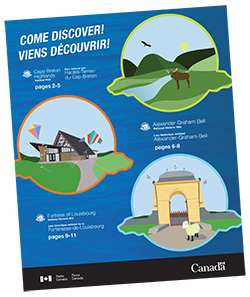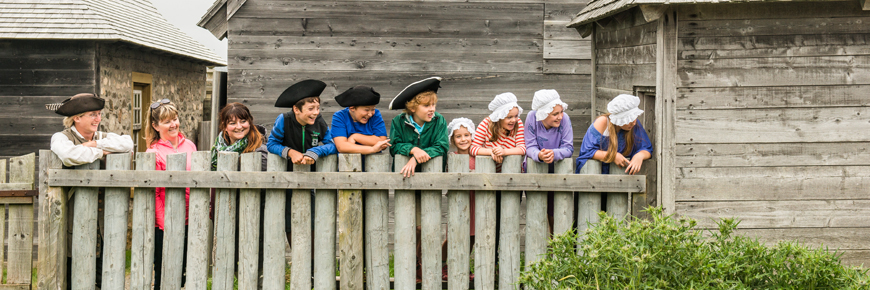
Kids' Corner
Fortress of Louisbourg National Historic Site
Activity booklet
Looking for even more activities?
Download our new activity booklet, featuring activities from all over Cape Breton Island and Canso!
Are you looking for some fun activities you can try at home while you learn about the Fortress of Louisbourg National Historic Site? Try some of these!
There are lots of things for our younger visitors to enjoy, from our Xplorers Program to Club Parka and so much more!
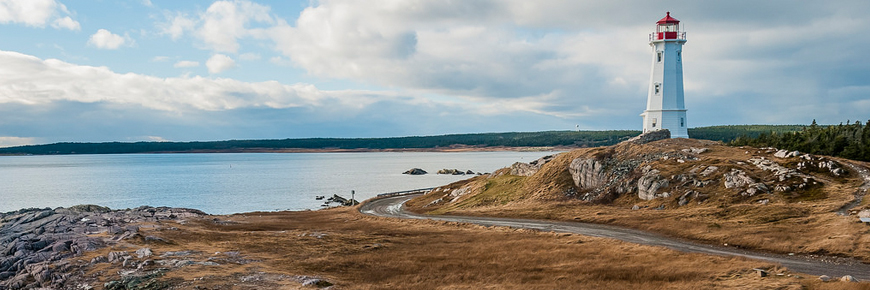
Louisbourg Lighthouse
Fun facts:
- Did you know that the first lighthouse in Canada was in Louisbourg? You can still see the stonework ruins from the original lighthouse at the site.
- There have been three lighthouses built at Lighthouse Point. The one you see today was built from 1922-1924.
- What is a lighthouse? A lighthouse helps to keep ships and sailors safe by shining a bright light to warn them that there are dangerous coastlines or rocks in the area, and in some cases helps to identify the entrance to a safe harbour.
Imagine you are visiting Lighthouse Point.
- Why do you think the lighthouse is built where it is?
- Imagine you are arriving on a ship in 1744. How do you think the lighthouse would help the captain of your ship?
- Pretend you are facing the water with the Fortress of Louisbourg back in the distance. Can you smell the ocean air? Do you see any seabirds? What are they doing? Can you name any?
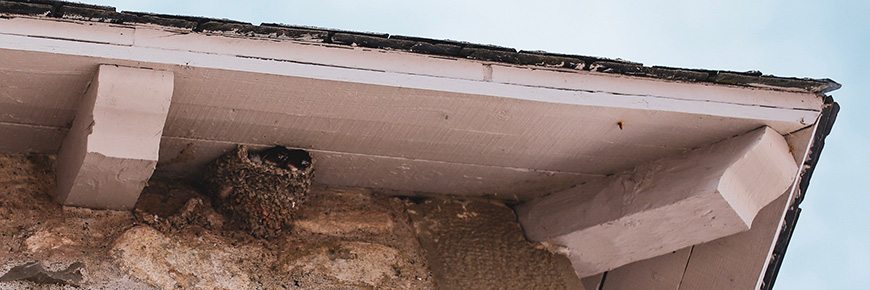
Barn swallows
The Fortress of Louisbourg is home to many barn swallows, which have been designated an endangered species in Canada under the Species at Risk Act. Since the 1970s, the population of barn swallows has been rapidly decreasing due to various factors such as lost of habitat, pesticides, timing of the swallows’ annual migration, availability of food source (insects) and climate change.
Parks Canada is helping to diminish the impacts of climate change by protecting and restoring healthy, strong ecosystems and contributing to the recovery of species at risk. The Fortress of Louisbourg buildings are a great habitat for the swallows. Whenever possible Parks Canada staff leave entryways or doors open to certain buildings at the fortress so that the swallows can have shelter.
The architecture of the Fortress and its isolation from modern day intrusions make it an ideal home for these seasonal birds. Parks Canada is always happy to see them return.
Nests are built from mud, and often lined with feathers, and sometimes twigs. The swallows carry the mud in their mouths to take back to where they make their nests. To make sure that the swallows have enough mud and water to build their nests, Parks Canada staff members build puddles for them. Below, you can learn how to build a replica nest out of papier-mâché!
Activity: Build a swallow's nest!
Stump your friends with these questions!
- Which body of water does Louisbourg border?
- Pacific Ocean
- Bras d'Or Lake
- Atlantic Ocean
- Great Lakes
-
Answer
c. Atlantic Ocean
- What is the King's Bastion?
- A boat
- A building
- A type of hat
- The king's pet cat
-
Answer
b. A building
- The French came to Louisbourg hundreds of years ago. In which year was Louisbourg founded?
- 1682
- 1704
- 1713
- 1743
-
Answer
c. 1713
- The Mi'kmaq were strong allies of the French during Louisbourg's occupation. Where did the Mi'kmaq live at Louisbourg?
- King's Bastion barracks
- St. Louis Hotel
- The Mi'kmaq visited Louisbourg, but lived in their own communities
- Louisbourg Lighthouse
-
Answer
c. The Mi'kmaq visited Louisbourg, but lived in their own communities.
- Which of the following was Louisbourg's chief export during its French occupation?
- Fish
- Fur
- Timber
- Coal
-
Answer
a. Fish
Activities
Before you get started, get an adult to help you prepare all the materials that you will need for your activity or craft. Always practice safety first when using scissors, glue, paint or sharp objects!
Make a lighthouse!
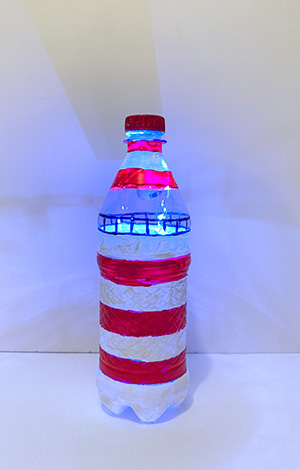 Pop bottle lighthouse
Pop bottle lighthouseWhat you need:
- Empty clear plastic bottle with cap
- White paint or white tape or white paper
- Red paint OR red tape OR red paper
- Black marker
- Glue (if using paper)
- Paint brush (if using paint)
Instructions:
- Cover the bottle with the white paint or tape or paper, ¾ of the way up
- Leave a roughly 5-centimetre (2-inch) section of the bottle clear, then paint or cover the remainder of the bottle above the clear section white
- The bottle cap should be red
- Let dry if using paint
- Next take your red paint, tape, or paper, and create red stripes approximately every 3 cm (1.5 inches) up the bottle to the clear section
- Then do the same for the neck of the bottle
- Draw a small gate around the clear section to resemble where the light is kept
You’re all done! If you are feeling adventurous, you could cut a hole in the back of the bottle and put a small battery-operated candle inside the bottle to give off light
Build a barn swallow's nest!
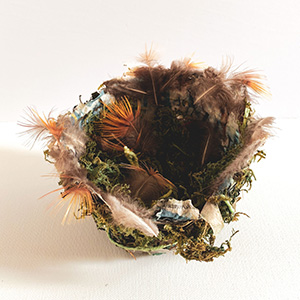 Swallow nest craft
Swallow nest craftWhat you will need:
- White glue
- Water
- Plastic wrap
- Small plastic bowl, about 15-20 centimetres (6-8 inches) across the top
- Shredded paper
- String or yarn – cut into 12-15 cm (4-6 inch) lengths
- Low, wide, plastic container to hold the glue
- Cover for the table (this can be a bit messy!)
- Optional: feathers, decorative moss
Instructions:
- Cover the outside of the bowl with a piece of plastic wrap. You may want to tape the wrap to the inside of the bowl so that it will be sure to stay in place.
- In the wide container, mix the glue with some water. Equal parts water and glue is suggested, but if you find it too thin you can add a bit more glue.
- Dip strips of the string/yarn and shredded paper in the glue and put it over the plastic wrap. You can rub any excess glue off with you fingers before putting it on the bowl. You can place the string and paper any way you wish - it does not have to be perfectly straight. (If you are also using the optional materials you can add these as well.) Continue until the plastic wrap is completely covered.
- Put your project in a safe place to dry. You will need to wait at least 24 hours before removing the nest from the bowl. If the glue is still wet leave the nest to dry a bit longer.
- Lift the nest from the bowl and carefully remove the plastic wrap. You may want to ask an adult for help.
- Hint: Want your nest to look natural? Use colours that you would find in nature like browns and greens!
- Discussion: Talk about what barn swallows use to hold their nests together (mud, feathers, etc.) and how you think they do this. Do you think your replica nest is fairly similar to a real nest?
Want to see what activities our other places have to offer?
Check out these links to the Kids' Corner at some of our places!
Related links
- Calendar of events
- Outreach Programs
- School Programs
- Louisbourg Lighthouse Centennial Celebrations
- Travel trade professionals
- Daily schedule
- Mi’kmaw Interpretive Centre
- Tours
- Fire a cannon: Have a blast at Louisbourg!
- Fire a musket: Have a ball at Louisbourg!
- Time Travel
- Overnight accommodations
- Prisoner of the Day
- Heritage gardens
- Dine around the fortress
- Walking trails
- Unsupervised beaches
- Parks Canada Xplorers
- Get involved: Volunteering
- Date modified :
